Product Description
Leviton R1616-2CB GreenMAX Relay Panel Insert with (16) 2-pole RTC relays
GreenMAX® Relay Panel Insert with (16) 2-pole RTC relays
GreenMAX 16-position Relay Insert Panel (fits 16, 32, 48-relay cabinets), with quantity of 16, Latching, 2-pole, Return-To-Closed basic, 30A 208/240/480, 600VAC 50/60Hz, Title 24 compliant, ASHRAE 90.1 compliant
The Leviton GreenMAX Relay Panel line offers features and performance not available from any competing product on the market today.
Description The Leviton GreenMAX® Relay Control Panel line offers features and performance not available from any competing product on the market today. For increased reliability and durability, GreenMAX Cabinets and Relay Modules have a 25,000A Short Circuit Current Rating (SCCR) at 277VAC. Native communication network protocols—BACnet/IP, Ethernet, and LumaCAN—are built into each GreenMAX Command Module (processor) to offer unparalleled connectivity. No additional parts or adapters are needed to communicate with other products utilizing these protocols. For increased flexibility, the modular GreenMAX system includes separate Cabinet enclosures, Command Modules (processor, power supply, and low voltage inputs), Relay Insert Panels, Relay Modules, and a Handheld Display Unit (HDU). For easier manageability and accessibility, Leviton ships empty cabinet enclosures separately from the electronic components. This makes the cabinets lighter and easier to handle and requires less effort to install. To further minimize handling and damage to the electronic components, Leviton can ship the electronic components later in the project schedule or as required. All GreenMAX Relay Modules are 1-pole or 2-pole latching relay types that reduce parasitic energy use. The relay modules are the same physical size, allowing the optimal mix of relays to be customized for each application. Models include a basic control relay module and/or a self-contained dimming and switching relay module that supports daylight harvesting capabilities. A Handheld Display Unit (HDU) can be detached from the cabinet mounting location and moved to the most convenient network connection point to connect to any open LumaCAN or port on the same network as the cabinets. Commissioning and start-up functions are easier with the HDU, which allows programming to be done in the space being controlled rather than from the electrical room.
Features • Cabinets and relay modules with 25,000A Short Circuit Current Rating (SCCR) at 277VAC • Relay modules rated at 30A General Fluorescent Ballast at 20A Incandescent • Relay modules are latching with manual actuator • Industry standard 0-10V dimming and switching relay module • Programming and monitoring of the system is done with the exclusive Handheld Display Unit (HDU) • Empty enclosure ships separately from electrical components • Supports native protocols of BACnet/IP, Ethernet, and LumaCAN • 8, 16, 32 and 48 relay sizes • Four programmable levels of demand response • Can be used to comply with IECC, ASHRAE 90.1, and 2022 Title 24, Part 6 occupancy/vacancy sensing, 0-10V dimming, daylight harvesting, partial-ON, partialOFF, scheduling, demand response, and receptacle control requirements
Relay Cabinet • GreenMAX cabinet has a 25,000A at 277VAC short circuit current rating (SCCR) for increased reliability and durability • Modular system includes separate empty cabinet enclosures, a command module, and relay insert panels to minimize handling and subsequent damage during installation • Command Module is the processor and power supply of the GreenMAX system and optionally includes a low voltage remote input card for analog devices • Relay insert panels feature quick install; each panel takes only two screws to install • Native communication network protocols—BACnet/ IP, Ethernet, and LumaCAN—are built into each command module to offer unparalleled connectivity; no additional devices are needed to communicate with other products utilizing these protocols • Increased arc flash protection—the cabinet door opens to expose only the low voltage area of the cabinet • High voltage areas can be accessed by removing the wire-way covers—this requires the removal of retaining screws • Voltage barriers can be installed between individual relay modules. This allows voltages from mixed sources in the same cabinet
Relay Module • All GreenMAX relay modules have a 25,000A short circuit current rating (SCCR) at 277V for increased reliability and durability • Rated at 30A general fluorescent ballast (this rating is 20A, 347V in Canada) and 20A incandescent for all GreenMAX relays • All relays are latching with a manual actuator to reduce parasitic energy waste over NO/NC relays • Manual actuation lever on all GreenMAX relays allow users to manually bypass the system to turn lights on or off without a CPU or power • Self-contained dimming and switching relay module in 1-pole configurations supports daylight harvesting capabilities
Remote Low Voltage (RLV) • Remote low voltage input cabinets can be installed closer to the devices they serve (such as occupancy sensors, LV switches and photocells) to reduce wiring and labor and provide additional power; this also makes commissioning and troubleshooting easier • Additional low voltage input points are available in quantities of 8 and 16 • Power supply input: 70W (max), 100-277VAC single phase input, 24VDC output • The RLV utilizes CAT6 network cable to interconnect with the system and communicates via LumaCAN
Handheld Display Unit (HDU) • Manage the GreenMAX system(s) remotely from any network device location • System configuration and scheduling is performed via the HDU—this can be done while standing in the room or controlled space; programming is no longer confined to the electrical room • Control entire GreenMAX system from any access point—relay cabinets, switches, or remote low voltage cabinets • One HDU can be used for multiple systems • Can be stored in the cabinet or designated docking station • Communicate via LumaCAN • 7-hour run time on a single full charge (batteries included) • Astronomical clock—sunrise/sunset • HDU does not need to be connected to system during operation. Full system functionality is provided independent of HDU








